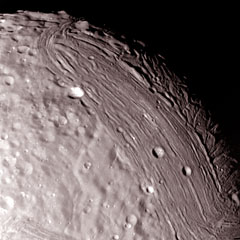Miranda
Current Theories
Immediately after the discovery of Miranda's cratered surface and geological activity, the Voyager team themselves put forward a theory: perhaps Miranda was struck hard enough to be fragmented and reassembled.[1] Since Miranda's proximity to Uranus exposes it to heavier bombardment than more distant moons, it was even proposed that Miranda could have fragmented and reformed several times. The gravitational contractions needed to turn it back into a spherical mass could provide the heat needed for geological activity.[1] However, this idea fell out of favor as soon as a more plausible, if less exciting, explanation was put forth: tidal heating, caused by orbital resonance.[2]
 Public domain animation of the 4:2:1 Laplace resonance between Ganymede, Europa, and Io. Found at wikipedia.com |
 Unusual "Chevron" figure seen on approach to Miranda. January 24, 1986. Range, 26,000 miles. From http://voyager.jpl.nasa.gov/ |
In addition to being unusually geologically active,[1] it is also strange that Miranda and its sister moons Ariel and Titania are not in any low-order resonances, unlike the systems of Jupiter and Saturn. This suggested to scientist that Miranda was once in a destabilizing orbital resonance.[3] A 3:1 resonance with Umbriel would increase Miranda's orbital inclination and eccentricity, in agreement with the number we see today.[4] However, this resonance alone cannot explain the significant heating Miranda must have experienced during its lifetime. Models for equilibrium tidal heating predict that even sustained heating from a 3:1 resonance could only raise the average temperature by about 16 K.[4] Even taking several other factors into consideration, including the fact that the central temperature rises about three times as fast as the average global temperature and that Miranda may have an unusual thermal conductivity, this model puts Miranda's temperature at about 175 K.[4] This tidal heating, therefore, cannot be responsible for the significant melting of water ice thought to be the cause of Miranda's scarred surface. A possible secondary 5:3 resonance with Ariel could account for some additional heating, although still not enough.
Although tidal heating through orbital resonance is currently the 'favored' theory, it certainly does not answer all the questions about Miranda. Unfortunately, until another mission re-images Uranus and its moons, the pictures taken by Voyager 2 are all the information we have, and it is just not enough.
[1] Smith, B. A. et. al. "Voyager 2 in the Uranian System: Imaging Science Results." Science. 233.4759 (1986): 43-64.
[2] Stone, E. C., and E. D. Miner. "The Voyager 2 Encounter with the Uranian System." Science. 233.4759 (1986): 39-43.
[3] Dermott, Stanley F., Renu Malhotra, and Carl D. Murray. "Dynamics of the Uranian and Saturnian Satellite Systems: A Chaotic Route to Melting Miranda?." Icarus. 76.2 (1988): 295-334.
[4] Tittemore, William C., and Jack Wisdom. "Tidal Evolution of the Uranian Satellites III. Evolution through the Miranda-Umbriel 3:1, Miranda-Ariel 5:3, and ArieI-Umbriel 2 : 1 Mean-Motion Commensurabilities." Icarus. 85.2 (1990): 394-443.
